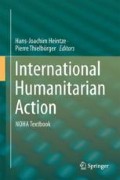Abstract
Humanitarian organisations tend to follow a rather ambiguous approach to security. On the surface, they usually recognise the value of professionally managing their security. However, security management is still too often seen as an alien concept grudgingly imported into the humanitarian world.
Special thanks to Sadia Bundgaard for her valuable editing of this text.
Access this chapter
Tax calculation will be finalised at checkout
Purchases are for personal use only
Notes
- 1.
According to Aid Worker Security Database, in 2014, 190 major attacks targeted humanitarian workers, http://www.aidworkersecurity.org.
- 2.
See European Interagency Security Forum: Security to go: a risk management toolkit for humanitarian aid agencies, http://mhpss.net/?get=263/Security-to-go_A-Risk-Management-toolkit-for-humanitarian-Aid-Agencies3.pdf.
- 3.
See definitions above for Impact, Threat and Vulnerability.
- 4.
As an example, in Iraq, a humanitarian organisation forced its staff to file leave requests before some field trips. In case of a security incident, the organisation could deny responsibility.
- 5.
The signs of such prevailing culture are the number of disclaimers staff are required to sign.
- 6.
There are obviously other sources of information ranging from open source media to confidential discussions with stakeholders.
- 7.
Arrangements can range from a WhatsApp dedicated group to a specific radio channel, depending on the context.
- 8.
The Good Humanitarian Donorship has contributed to this discussion.
- 9.
If preferred communication means are not available 24/7 alternate communication system should be set up, including emergency telephone numbers etc.
- 10.
Medical data from the support process should be managed in accordance with medical ethics.
- 11.
For details on acceptance, please refer to the Acceptance Toolkit: http://acceptanceresearch.files.wordpress.com/2012/01/acceptance-toolkit-final-for-print-with-notes.pdf.
- 12.
Here the contracting agency is the organisation that subcontracts the implementation to an implementation partner.
- 13.
For a thorough analysis of the consequences of this case, see Hoppe and Williamson, ODI HPN, April 2016.
- 14.
According to Aid Worker Security Database, in 2014, 329 humanitarian workers were hurt in a security incident, 121 were killed, 88 injured and 120 kidnapped.
- 15.
The most renowned is the Economist Intelligence Unit that focuses on the economy. Some private intelligence agencies, such as Stratfor or Control risk, focus more on security while others such as Site Intel Group focus specifically on violent and jihadi groups.
- 16.
What we can learn from the epic failure of Google flu trends, http://www.wired.com/2015/10/can-learn-epic-failure-google-flu-trends.
- 17.
For more on stress management in humanitarian organisations, please refer to the Antares Foundation (www.antaresfoundation.org) and the Headington Institute (www.headington-institute.org).
References
European Interagency Security Forum: Security to go: a risk management toolkit for humanitarian aid agencies, http://mhpss.net/?get=263/Security-to-go_A-Risk-Management-toolkit-for-humanitarian-Aid-Agencies3.pdf
Hoppe K, Williamson C (2016) Dennis vs Norwegian Refugee Council: implications for duty of care. Online. ODI, http://odihpn.org/blog/dennis-vs-norwegian-refugee-council-implications-for-duty-of-care/ consulted on 24 June 2015
Further Reading
Allié M (2011) Acting at any price? Humanitarian negotiations revealed: the MSF experience. Hurst & Company, London
Behn O, Kingston M (2010) Whose risk is it anyway? Linking operational risk thresholds and organisational risk management. Humanitarian Exchange Magazine (47), June 2010
Collinson S, Duffield M (2013) Paradoxes of presence: risk management and aid culture in challenging environments. Humanitarian Policy Group, Overseas Development Institute
Egeland J, Harmer A, Stoddard A (2011) To stay and deliver: good practice for humanitarians in complex security environments. United Nations Office for the Coordination of Humanitarian Affairs (OCHA)
Fast L, O’Neill M (2010) A closer look at acceptance. Humanitarian Exchange Magazine, Issue 47, Humanitarian Practice Network
HAP International (2013) Guide to the 2010 HAP standard in accountability and quality management. HAP International, Geneva
Harmer A, Stoddard A, Toth K (2013) Aid Worker Security Report 2013: the new normal: coping with the kidnapping threat. Humanitarian Outcomes
Humanitarian Outcomes. Aid Worker Security Database. http://www.aidworkersecurity.org
Humanitarian Practice Network (2010) Operational security management in violent environments: Good Practice Review 8, revised edition. Overseas Development Institute
Kemp E, Merkelbach M (2011) Can you get sued? Legal liability of international humanitarian aid organisations towards their staff. Policy Paper, Security Management Initiative
Kingston M, Behn O (2010) Risk thresholds in humanitarian assistance. European Interagency Security Forum
Kingston M, Behn O Risk transfer through hardening mentalities? Humanitarian Practice Network. Online. http://www.odihpn.org/the-humanitarian-space/blog/risk-transfer-through-hardening-mentalities
Mission Ready. Online. Missionready.org.uk
Roberts DL (2006) Staying alive: safety and security guidelines for humanitarian volunteers in conflict areas. International Committee of the Red Cross
Stoddard A, Harmer A, Hughes M (2012) Aid Worker Security Report 2012: host states and their impact on security for humanitarian operation. Humanitarian Outcomes
Van Brabant K (2010) Managing aid agency security in an evolving world: the larger challenge. European Interagency Security Forum
Van Brabant K (2012) Incident statistics in aid worker safety and security management: using and producing them. European Interagency Security Forum
Wille C, Fast L (2013) Shifting patterns in security incidents affecting humanitarian aid workers and agencies: an analysis of fifteen years of data (1996–2010). Insecurity Insight
Author information
Authors and Affiliations
Corresponding author
Editor information
Editors and Affiliations
Rights and permissions
Copyright information
© 2018 Springer International Publishing AG
About this chapter
Cite this chapter
Ghosn, B. (2018). Security Management in Humanitarian Organisations. In: Heintze, HJ., Thielbörger, P. (eds) International Humanitarian Action. Springer, Cham. https://doi.org/10.1007/978-3-319-14454-2_23
Download citation
DOI: https://doi.org/10.1007/978-3-319-14454-2_23
Published:
Publisher Name: Springer, Cham
Print ISBN: 978-3-319-14453-5
Online ISBN: 978-3-319-14454-2
eBook Packages: Law and CriminologyLaw and Criminology (R0)

